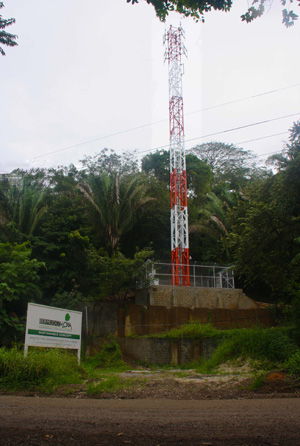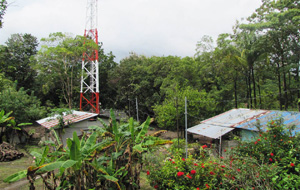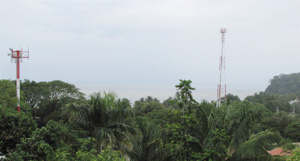International concerns about health hazards and citizens' concerns about where cell phone towers are located were minimized by a recent ruling of the Costa Rican Constitutional Court. La Nación reports that the Court ruled in favor of allowing cell phone companies to erect towers where they see fit.
The decision issued by the high court (Sala IV) on November 16th declared that the companies' ability to create a "solid, robust and uniform infrastructure" is of national interest. Under the Court's ruling, local municipal governments cannot create regulations or requirements that impede cell phone companies from locating to meet their needs.
"The cell phone towers comply with technical requirements. They are permitted in a low-density residential zone, in a commercial or industrial zone," Magistrate Ernesto Jinesta told La Nación.
No Voice in the Matter
Environmental lawyer Álvaro Sagot has filed a constitutional claim before the Constitutional Court. He asserts that the installation of cell phone towers has been done in a way that contravenes Costa Rica's Free Trade Agreement with the United States.
In the digital newspaper elpais.cr, Sagot expressed his concern that people aren't being allowed to have a voice in the location of towers, stating: "As a citizen I have the right to know before an environmental permit is issued that this type of project will be installed in my neighborhood. I have the right to oppose it, to be informed of it and to participate in the process. All that has been taken from me by means of a directive that leave my participation for stages when the project has already begun."
VON reader Marq Benoit in a comment posted on VON's Facebook page complains of the same problem. In response to an article in November about recent construction of new cell phone in the Nosara area, Benoit wrote, "So, one landowner gets money for ten years and the rest of the town suffers! That's why there should be meetings with the community BEFORE they decide where to place these towers. Let the community decide where they should go, not the company! It's called democracy!" |
|
 |
| |
|
| |
 |
| |
|
| |
 |
Pablo Marín and his wife Pamela Arrieta likewise disagree with the way the tower was built in Los Arenales of Nosara: "They didn't consult us to put it there; we just saw the sign and when it was in place." Maritza Arrieta García also from Los Arenales expressed, "I'm not in agreement with the cellular tower; they never asked me. They say it's bad; I've heard that it's bad for one's health, it causes cancer."
On the other hand, other VON readers recognized the desire for better cell phone coverage. Martin Chacón Rodríguez commented that the towers are needed "to communicate easily with the world," and Don Pasley Jr. remarked that "if you want modern technology and amenities, this is what you get." He added, "I'll bet the loudest complaint was for having the latest technology WITHOUT thinking about the consequences like the current ones you have." Similarly, Nelson Alemán Mesa from Nosara commented, "I'm in agreement with the towers being there, as long as they function."
In reference to the tower located after Blue Spirit, Yorleni Mora Sánchez expressed a favorable attitude. "It doesn't hurt me at all. They're going to put another tower 50 meters from here. My husband signed a contract," she related.
The Debate about Health Effects
Not only are some people demanding to have their opinions as citizens considered by the government and private companies, many also are concerned about the health consequences of long-term exposure to emissions from the cell phone towers. The Minister of Health in Costa Rica, based on the World Health Organization (WHO) investigations, has said that the consequences are minimal and do not seriously affect human health. However, there is an international debate that doesn't completely agree with the Minister or the WHO findings.
For example, the International Conference on Cell Tower Siting held in Salzburg, Austria in June of 2000 brought together leading scientists and experts who reviewed the results of numerous studies. |
|
|
Tolerated and Recommended Power Densities
United States-IEEE: 6 W/m2 for 900MHz
United States-IEEE: 12 W/m2 for 1800MHz
Costa Rica ICNIRP (OMS): 4.24 W/m2 for 850MHz
Costa Rica ICNIRP (OMS): 9 W/m2 for 1800MHz
Costa Rica ICNIRP (OMS): 10 W/m2 for 2100MHz
Catalonia: 2 W/m2 for 900MHz
Chile: 1 W/m2 for 900MHz
Australia:2 W/cm2 (note different unit of measurement)
Italy: 0.1 W/m2
Mainland China: 0.066 W/m2
Switzerland: 0.042 W/m2 for 900MHz
Switzerland: 0.1 W/m2 for 1800MHz
Russia and Eastern Europe: 0.024 W/m2
C.E. Europe (norm IEC 601-1-2/98): 0.027 W/m2
Sweden: 0.02 W/m2
Salzburg: 0.001 W/m2
Many countries have set limits on tower emissions, but the guidelines vary considerably from country to country with some countries establishing very strict regulations. Sweden permits a maximum 0.02 watts per meter squared (W/m2) and mainland China's limit is 0.066 W/m2. Other countries have established more tolerant levels. Costa Rica permits a range from 4.24 W/m2 for 850 megahertz to 10.0 W/m2 for 2100MHz; and the United States' range is 6.0 W/m2 for 900MHz to 12.0 W/m2 for 1800MHz. |
|
They concluded, "The rapid development in the mobile telecommunications area led and leads to an increasing burden of exposure due to electromagnetic fields in the immediate environment of the population. In order to guarantee that these technologies, working in the high-frequency range with variable modulations, have no negative impacts on human health and well-being, it is essential to restrict the exposure."
More recently, in February of 2011, The International Electromagnetic Fields Alliance (IEMFA) issued a report concerning the health hazards of electromagnetic fields (EMFs). Based on the latest evidence in biological sciences, the consortium of international scientists urged governments to adopt significantly lower human exposure standards for electromagnetic fields. According to the Seletun Scientific Panel, new biologically-based public exposure standards are urgently needed to protect long-term public health worldwide since current public-safety EMF-exposure guidelines only consider damage generated by a heating effect and don't take into account prolonged, low-intensity exposure.
Many are still concerned about harm that might be caused by long-term exposure to the towers. The director of the school in Samara, Maria Luisa Villareal Muñoz, expressed concern about the tower now located right behind the school in the center of Samara. "Personally I feel it is very dangerous," she said, and for two reasons. One reason is the risk of the tower falling on the school in the event of an earthquake. She is also concerned about the health of the school children. "The microwaves that they radiate are damaging," she said.
Mariano Villera now has a tower almost in his backyard in El Torito of Samara. He remarked that SETANA (The National Environmental Technical Secretary) is supposed to look out for the environment and ensure that they don't get harmed; however he feels that was not done in this case.
Those who are upset about suddenly having a cell phone tower located near their homes seem to have limited recourses. For the time being, the cell phone towers will remain as unwelcome neighbors.
 |
| |
More Regional News
Robbery Suspect Arrested, Guiones Residents Breathe Easy
Residents of Las Huacas will have hopefully rested more easily after this Friday January 20th following the arrest of a man who has allegedly been thieving from homes in the area for well over a year. The arrest came this morning after Francisco Chavarria Rodriguez, a security guard of the private company Securtiy Pacific, found the man sleeping in a hammock covered in leaves behind a residents house in a gully.
Man in Jail After Stabbing Ex-Girlfriend in Samara
The man who repeatedly stabbed his ex-girlfriend when she was leaving work at Villas Playa Samara on Wednesday, January 11th, was apprehended the following day and has been sentenced to three months of preventive imprisonment in Liberia, as verified by Ronald Alvarez, supervisor of the Public Force for Nicoya canton.
Alcohol is Suspected Culprit of Death in Samara
On Monday morning, January 9th, Bruce Frederick Corbitt, an American man around 60 years old, was found dead on the floor of the room where he was staying in Samara.
Flights take off from new air terminal in Liberia on Thursday
Good news for those who visit Nosara and Samara via the Daniel Oduber airport in Liberia: new installations are prepared to begin functioning this Thursday, January 12th, at 6:50 in the morning, when the first national flight from Nature Air with touch the runway and inaugurate the new facilities, as announced by Minister of Transportation Francisco Jimenez.
2012 Municipal Budget Held Up by Procedural Disputes
The 2012 Municipal budget for the Canton of Nicoya is being stalled due to disputes over the proper approval procedure, and the dispute is raging online on the Facebook page of the Alcaldia de Nicoya.
The Future of Tourism
Chambers of Tourism in Nosara, Samara and Carrillo Developing New Strategies
While tourism in Costa Rica is increasing in general, the coastal destinations of Nosara and Samara remain at the bottom of the list of tourist destinations in Guanacaste. According to data provided by CATURGUA, the Guanacaste Chamber of Tourism, only 1% of international tourists visit Nosara and 2% visit Samara.
Council's President Under Investigation for Hiring Without Due Process
• The contract was for fireworks
Nicoya's Council's President, Juan Luis Aguirre Vidaurre, is being investigated by the Town Council for hiring the fireworks used on December 31st, 2010, without following due process. The fireworks display had a cost of $800 however, a year later, the owner of the company hired is still walking the halls of Nicoya's Municipalidad, bill in hand, looking for someone to pay him what he is owed.
Mystery shrouds the death of poisoned high school student
Four months have passed since the town of Nosara was shocked by the death of Hernandez, a 17-year-old high school student, after being poisoned by two alleged assailants while on his way to school. With a fire arm, the two obligated him to consume a herbicide after taking his cellular phone and 50,000 colones ($100).
|
 |
|
|

